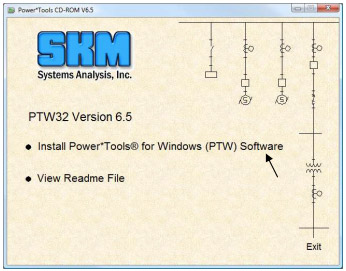Skm Power Tools Full Version

Since 1972, SKM System Analysis Inc. Has been the market leader in power systems analysis and design software.
With the release of Power.Tools for Windows Version 7.0, SKM has reached newer heights with the most productive software to be released in its 40 year history to the professional engineering community.New PTW software features accelerated tasks, enhanced reporting, increased equipment libraries, improved workflow, addition of new study options and more to meet challenging industry demands.The SKM Suite includes the following tools. CAPTOR produces time versus current coordination drawings with one-line diagrams and setting reports. It lets you coordinate protective devices with interactive on-screen graphics, and provides a comprehensive library. You can print on preprinted graph paper or on plain paper with custom grids and layouts. CAPTOR may be used on any electrical power system including utility, industrial, commercial, manufacturing, and process systems. Devices may be plotted at any voltage, current of application frequency. The most comprehensive library containing protective devices from all of the popular equipment manufacturers is included.

Skm Power Tools Download
CAPTOR’s advanced device modeling and curve fitting techniques make library additions fast and easy. PTW Arc Flash Evaluation calculates the incident energy and arc flash boundary for each location in a power system. Arc Flash saves time by automatically determining trip times from the protective device settings and arcing fault current values. Incident energy and arc flash boundaries are calculated following the NFPA 70E and IEEE 1584 standards. Clothing requirements are specified from a user-defined clothing library.

Clearing times can be automatically reduced based on current-limiting capabilities. AFAULT provides fault calculations in full compliance with the ANSI C37 standards.
Skm Power Tools Full Version Pdf
It offers separate solutions for low, medium and high voltage systems and for symmetrical, momentary and interrupting calculations as defined in the standards. For medium and high voltage systems, the momentary and interrupting values may be calculated using either the E/X or E/Z methods permitted by the standards. Both ac and dc decrement curves required by the total current rated standard (C37.5) and the symmetrical rated standard (C37.010) are used by the program.
PTW IEC60909 calculates short-circuit currents using the equivalent voltage source as required by the IEC 60909 standard. With PTW IEC60909, three-phase and unbalanced fault duties for electrical power systems are calculated in compliance with the IEC 60909 standards for low, medium, and high voltage systems.
Skm Power Tools Full Version Online
PTW IEC61363 Short Circuit Study The IEC61363 Short Circuit Study module calculates the current that flows in an electrical power system under abnormal conditions. These currents must be calculated in order to adequately specify electrical apparatus withstand and interrupt ratings and selectively coordinate time current characteristics of electrical protective devices.
The IEC61363 Short Circuit study represents conditions that may affect typical marine or offshore installations more significantly than land-based systems, including more emphasis on generator and motor decay. The calculation methods are intended for use on unmeshed three-phase a.c. Systems operating at 50Hz or 60Hz; having any system voltage specified in IEC 60092-201 table 2; having one or more different voltage levels; comprising generators, motors, transformers, reactors, cables and converter units; having their neutral point connected to the ship’s hull through an impedance; or having their neutral point isolated from the ship’s hull. The Equipment Evaluation Study module compares protective device ratings with short-circuit calculations. The program also checks for missing input data and compares continuous ratings to calculated design and operating conditions.
Equipment that fails the evaluation are reported in table form and color-coded by the one-line diagrams. As with all PTW study modules, Equipment Evaluation uses the same project database, integrating all balanced and unbalanced/single-phase study modules, and allowing you to examine existing projects without additional input requirements. The Transient Motor Starting Analysis module (TMS) is a state-of-the-art time simulation program to analyze all aspects of motor starting problems accurately. TMS models up to 1500 motors dynamically throughout starting, stopping or reacting to load changes. In order to completely examine motor starting problems, TMS has the capability to dynamically represent motors which are already on line at the beginning of the simulation. The complete network is continuously modeled throughout the time simulation in order to properly represent the interactions between motors and to be able to examine the effects of static loads, transformer taps, generator voltage setpoints, and all other network parameters.
HIWAVE simulates resonance and harmonic distortion in industrial, commercial, and utility power systems. Harmonic current and voltage sources may be defined at multiple locations in the power system. Capacitor banks, single tune filters and high pass filters may be included in the voltage and current distortion evaluation, impedance resonance scans, and in harmonic load flow results. Any type of system design, with any combination of voltage levels may be evaluated with this highly interactive, user friendly software. With HIWAVE, new power systems may be examined before they are built and the harmonic effects addressed during the design. Existing power systems may be studied and corrective filter designs evaluated before they are installed. Every bus and branch in the power system may be quickly evaluated for harmonic content and for resonant impedance characteristics.
PTW Unbalanced Studies simulates systems with single-phase, two-phase and unbalanced three-phase load conditions. Phase and sequence currents can be displayed for different operating and load conditions including open-phase and simultaneous faults. Studies include demand load analysis, sizing, load flow/voltage drop and short circuit. Reports also include three-phase and single-phase panel schedules. Modeling includes single-phase, two-phase and three-phase lines, transformers, loads, and capacitors as well as single-phase mid-tap transformers.